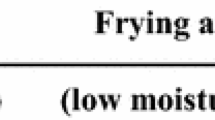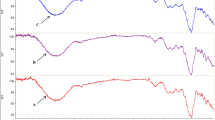Abstract
The presence of acrylamide in numerous food products has recently been demonstrated. In this work, the possibility of acrylamide formation in date fruits and date syrups was investigated for the first time. In this study, dates at the stages of Khalal, Rutab, and Tamr, some important date varieties in Iran, were analyzed along with the manufacturing conditions in which date syrup was industrially produced. Quality parameters such as pH, soluble solid content, color values (L*, a*, b*), moisture content, reducing sugars, and amino acid profile, as well as acrylamide concentration were determined in the date fruit and syrup samples. The results demonstrated that the analyzed date syrup samples contained acrylamide in the range of 141–554 ppb; however, acrylamide was not detected in the date fruit samples. It is worth mentioning that the tolerable daily intake (TDI) of acrylamide is 40 ppb per day for neurotoxicity and 2.6 ppb per day for cancer. The free asparagine concentrations in the fruit samples (17.4–44 ppm), ripening stages (7.4–66.1 ppm), and date syrup samples (15.4–63 ppm) were also measured. There was a strong positive correlation between the presence of acrylamide in the date syrups and the soluble solid content, asparagine level, and reducing sugar concentrations in most samples. The results of this work indicated that acrylamide can be produced at a relatively high level in date syrups during processing, and can pose a health risk for the Iranian population.



Similar content being viewed by others
References
V.M. Karizaki, Iranian dates and ethnic date-based products. J. Ethn. Foods (2017). https://doi.org/10.1016/j.jef.2017.08.002
A. Lemlem, M. Alemayehu, Date palm production practices and constraints in the value chain in afar regional state, Ethiopia. Adv. Agric. (2018). https://doi.org/10.1155/2018/6469104
S. Hajian, Z. Hamidi-esfahani, Date palm status and perspective in Iran, in Africa and the Americas. ed. by J.M. Al-Khayri (Springer, Dordrecht, 2015), pp. 19–47. https://doi.org/10.1007/978-94-017-9707-8
H. Pejman, A view on date palm situation and its research program in Iran. in Proc. of Date Palm Global Network Establishment Meeting (UAE University, Al Ain, 2002), pp 71–80. https://doi.org/10.1016/0308-8146(95)99840-V
S. Ghnimi, S. Umer, A. Karim, A. Kamal-eldin, Date fruit (Phoenix dactylifera L.): an underutilized food seeking industrial valorization. NFS J. 6, 1 (2017). https://doi.org/10.1016/j.nfs.2016.12.001
I.S.A. Ahmed, K.N. Al-Gharibi, A.S. Daar, S. Kabir, The composition and properties of date proteins. Food Chem. 53, 4 (1995)
M.A. Al-farsi, Clarification of date juice. Int. J. Food Sci. Technol. 38, 241–245 (2003)
L.M. Crawford, T.S. Kahlon, S.C. Wang, M. Friedman, Acrylamide content of experimental flatbreads prepared from potato, quinoa, and wheat flours peels and mushroom powders. Foods 8, 228 (2019). https://doi.org/10.3390/foods8070228
E. Abt, L.P. Robin, S. Mcgrath, J. Srinivasan, Y. Adachi, S. Chirtel, E. Abt, L.P. Robin, S. Mcgrath, J. Srinivasan, Acrylamide levels and dietary exposure from foods in the United States, an update based on 2011–2015 data. Food Addit. Contam. Part A (2019). https://doi.org/10.1080/19440049.2019.1637548
P. Taylor, T.M. Amrein, L. Andres, F. Escher, R. Amadò, Occurrence of acrylamide in selected foods and mitigation options. Food Addit. Contam. (2007). https://doi.org/10.1080/02652030701242558
M. Nasrolah, M. Honarvar, M. Erfan, A. Zulfiqar, M. Hossein, The occurrence of acrylamide in Iranian date syrup. J. Food Biosci. Technol. 9, 65 (2019)
P.B. Pathare, U.L. Opara, F.A. Al-said, Colour measurement and analysis in fresh and processed foods: a review. Food Bioprocess Technol. (2013). https://doi.org/10.1007/s11947-012-0867-9
S. Bogdanov, Authenticity of honey and other bee products: state of the art. Bull. USAMV-CN 63, 64 (2007)
E.K. Paleologos, M.G. Kontominas, Determination of acrylamide and methacrylamide by normal phase high performance liquid chromatography and UV detection. J. Chromatogr. A 1077, 128–135 (2005). https://doi.org/10.1016/j.chroma.2005.04.037
P. Taylor, M. Oroian, S. Amariei, G. Gutt, Surveillance acrylamide in Romanian food using HPLC-UV and a health risk assessment. Food Addit. Contam. Part B (2015). https://doi.org/10.1080/19393210.2015.1010240
I. Smutniak, J. Rubaj, W. Korol, K. Szkudzin, Method validation for determination of amino acids in feed by UPLC. Accredit. Qual. Assur. (2017). https://doi.org/10.1007/s00769-017-1281-9
W. Al-shahib, R.J. Marshall, The fruit of the date palm: its possible use as the best food for the future ? Int. J. Food Sci. Nutr. (2009). https://doi.org/10.1080/09637480120091982
A. Farahnaky, M. Mardani, G. Mesbahi, M. Majzoobi, M.T. Golmakani, Some physicochemical properties of date syrup, concentrate, and liquid sugar in comparison with sucrose solutions. J. Agr. Sci. Tech. 18, 657–668 (2016)
Y. Xu, B. Cui, R. Ran, Y. Liu, H. Chen, G. Kai, J. Shi, Risk assessment, formation, and mitigation of dietary acrylamide: current status and future prospects. Food Chem. Toxicol. 69, 1–12 (2014). https://doi.org/10.1016/j.fct.2014.03.037
M. Masmoudi, W. Kchaou, S. Danthine, C. Blecker, H. Attia, S. Besbes, Effect of enzymatic treatment on rheological properties, glass temperature transition and microstructure of date syrup. LWT Food Sci. Technol. 60, 339–345 (2015). https://doi.org/10.1016/j.lwt.2014.08.027
A.A. Elbashir, M.M.A. Omar, W. Aini, W. Ibrahim, J. Oliver, H.Y. Aboul-enein, Critical reviews in analytical chemistry acrylamide analysis in food by liquid chromatographic and gas chromatographic methods acrylamide analysis in food by liquid chromatographic and gas chromatographic methods. Crit. Rev. Anal. Chem. (2014). https://doi.org/10.1080/10408347.2013.829388
C. Pelin, B. Gündüz, M.F. Cengiz, Acrylamide contents of commonly consumed bread types in Turkey. Int. J. Food Prop. (2015). https://doi.org/10.1080/10942912.2013.877028
S. Eslamizad, F. Kobarfard, C. Tsitsimpikou, A.M. Tsatsakis, K. Tabib, H. Yazdanpanah, Health risk assessment of acrylamide in bread in Iran using LC-MS/MS. Food Chem. Toxicol. (2019). https://doi.org/10.1016/j.fct.2019.02.019
T.M. Amrein, A. Limacher, B. Conde-Petit, R. Amadò, F. Escher, Influence of thermal processing conditions on acrylamide generation and browning in a potato model system. J. Agric. Food Chem. 54, 5910–5916 (2006). https://doi.org/10.1021/jf060815c
S.G. Kulkarni, Effect of processing of dates into date juice concentrate and appraisal of its quality characteristics. J. Food Sci. Technol. (2010). https://doi.org/10.1007/s13197-010-0028-y
J.J. Knol, Kinetic modeling of acrylamide formation in aqueous reaction systems and potato crisps: text & figures (2008)
S.N. Al-hooti, J.S. Sidhu, J.M. Al-saqer, A. Al-othman, Chemical composition and quality of date syrup as affected by pectinase/cellulase enzyme treatment. Food Chem. 79, 215–220 (2002)
W. Regional, Chemistry, biochemistry, and safety of acrylamide. A review. J. Agric. Food Chem. 51, 4504–45026 (2003)
E. Areke, P. Ydberg, P. Arlsson, S. Riksson, Analysis of acrylamide, a carcinogen formed in heated foodstuffs. J. Agric. Food Chem. 50, 4998–5006 (2002)
T. Krishnakumar, R. Visvanathan, Acrylamide in food products: a review. J Food Process Technol (2014). https://doi.org/10.4172/2157-7110.1000344
Z.S. Hamide, A simplified approach for the kinetic characterization of acrylamide formation in fructose-asparagine model system. Food Addit. Contam. 23, 348–354 (2006). https://doi.org/10.1080/02652030500482355
Funding
This research did not receive any specific grant from funding agencies in the public, commercial, or not-for-profit sectors.
Author information
Authors and Affiliations
Corresponding author
Additional information
Publisher's Note
Springer Nature remains neutral with regard to jurisdictional claims in published maps and institutional affiliations.
Rights and permissions
About this article
Cite this article
Bahrami, M.E., Honarvar, M. & Nasrolah, M. Potential for acrylamide formation in Iranian dates and date syrups; influence of amino acids and processing condition. Food Measure 15, 4073–4082 (2021). https://doi.org/10.1007/s11694-021-00977-9
Received:
Accepted:
Published:
Issue Date:
DOI: https://doi.org/10.1007/s11694-021-00977-9




